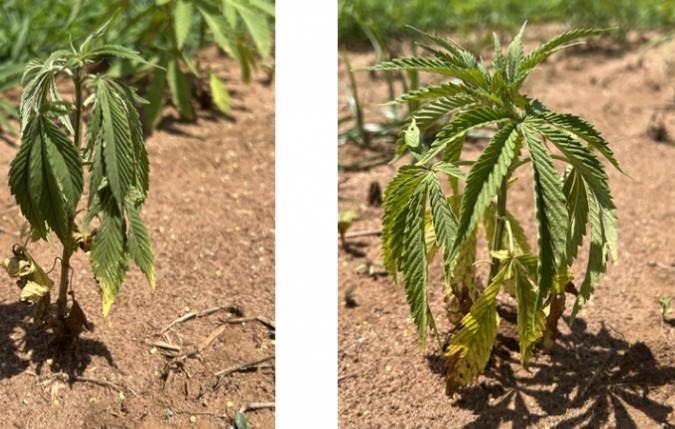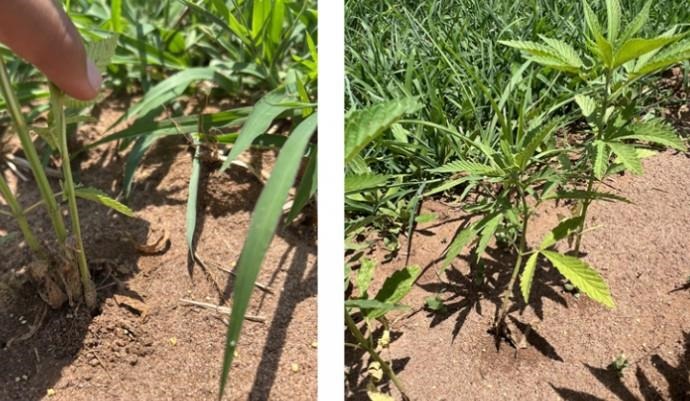By Hardeep Singh
Hemp is relatively new crop for Florida. Information for hemp production such as suitable varieties, best management practices, insect and pest management, weed control, and invasion risk in natural areas are just beginning to be established through research. The UF/IFAS Industrial Hemp Program is conducting research to provide producers and industry members with sound and reliable information. During the initial years of research trials in central and north Florida, fire ants (Solenopsis invicta Buren) have been observed to cause severe damage to hemp plants during the initial establishment and growth phase, impacting the hemp stand in the field.
Fire ants are reported to cause severe damage to other crops, vegetable gardens, and lawn areas throughout the Southeastern United States (1). There are some reports of fire ant damage to hemp in Alabama as well (2). In this article we discuss the identification of fire ant damage to hemp plants and some insecticides that are approved by Florida Department of Agriculture and Consumer Services (FDACS) for controlling fire ants.
Identifying damage
Hemp plants damaged by fire ants will exhibit water deficit symptoms (Fig 1). To confirm that the damage is due to fire ants, look for ant mounds (Fig 2) around the plant and girdling or striping of stem bark at the plant base (Fig 3). Fire ants develop mounds that may occur around the base of a plant. Resident ants then chew and girdle the hemp plant stem. Girdling or striping of stem result in obstructed water and nutrient movement from root system to the rest of the plant and ultimately results into plant death. Most of the damage occurs when the hemp plants are young, and the stem is soft. However, there are some reports of fire ants damaging full grown hemp plants by burrowing deep holes into plant stem.

Fig 1. Hemp plants damaged by fire ants showing water deficit symptoms. Photo by Hardeep Singh

Fig 2. Fire ant mounds around the hemp plants. Photo by Hardeep Singh

Fig. 3. Girdling or striping of stem bark at hemp plant base. Photo by Hardeep Singh
Control
For control of fire ants, it is essential to kill the queen or stop her from reproducing new worker ants. There are some insecticides which are labeled for fire ant control and are approved by FDACS for their use in Florida for hemp production. Most insecticides are applied as baits that hinder the reproductive capacity of queen while not killing worker ants. Therefore, growers will see results of insecticide application within four to six weeks as no new worker ants will be produced and old worker ants die due to aging. Additionally, in order to get effective control, make sure the worker ants are actively foraging so that they retrieve the bait. To check if worker ants are actively foraging or not, place a food product that contains oil (e.g., potato chips or hot dogs) and monitor for ant cover. If ants cover the food within 20 minutes, it is a good time to apply bait. Additionally, while choosing an insecticide for fire ant control, be careful that to protect beneficial insects which act as biological control for white flies and aphids. The list for these insecticides approved by FDACS and labeled for fire ants is provided in Table 1. And Table 2 lists the insecticides approved by FDACS labeled for broad insect control, but not labeled for fire ants.
Table 1. FDACS Approved Insecticides Labeled for Fire Ants
| Product Brand Name | Company Name | EPA Registration Number | Active Ingredient | Pesticide Type |
| Bonide Diatomaceous Earth Crawling Insect Killer | Bonide Products, INC. | 73729-1-4 | Diatomaceous Earth | Insecticide |
| Botaniguard Maxx | Lam International Corporation | 82074-5 | Pyrethrins, Beauvaria Bassiana Strain GHA | Insecticide |
| Debug ON | Agro logistic systems, INC. | 70310-11 | Neem oil | Insecticide, Miticide, Fungicide |
| Debug Optimo | Agro logistic systems, INC. | 70310-7 | Neem oil, Azadirachtin | Insecticide, Miticide, Fungicide, Nematicide |
| Debug Tres | Agro logistic systems, INC. | 70310-8 | Neem oil, Azadirachtin | Insecticide, Miticide, Fungicide, Nematicide |
| Debug Turbo | Agro logistic systems, INC. | 70310-5 | Neem oil, Azadirachtin | Insecticide, Miticide, Fungicide, Nematicide |
| Extinguish Professional Fire Ant Bait | Wellmark International | 2724-475 | (S)-Methoprene | Insecticide |
| Ferti-lome Triple Action Plus RTU | Voluntary Purchasing Groups, INC. | 70051-74-7401 | Pyrethrins, Piperonyl butoxide, Clarified hydrophobic extract of neem oil | Insecticide, Fungicide, Miticide |
| Pyronyl Crop Spray | Central Garden & Pet Company | 89459-26 | Pyrethrins, Piperonyl Butoxide | Insecticide |
| Shield-All Plus | Gardens Alive | 70051-111-56872 | Pyrethrins, Clarified Hydrophobic Extract of Neem Oil | Insecticide, Fungicide, Miticide |
Table 2. FDACS Approved Insecticides Not Labeled for Fire Ants with Broad Insect Control
| Product Brand Name | Company Name | EPA Registration Number | Active Ingredient | Pesticide Type |
| Azatin O | OHP, INC. | 70051-9-59807 | Azadirachtin | Insecticide |
| Azaguard | Biosafe Systems | 70299-17 | Azadirachtin | Insecticide, Nematicide |
| Azamax | Parry America, INC. | 71908-1-81268 | Azadirachtin | Insecticide, Miticide, Nematicide |
| Deadzone | Imerys Filtration Minerals | 73729-1 | Diatomaceous Earth | Insecticide |
| Pyganic Specialty | MGK | 1021-1772 | Pyrethrins | Insecticide |
| Pyganic crop protection | MGK | 1021-1772 | Pyrethrins | Insecticide |
| Pyganic Speciality | MGK | 1021-1772 | Pyrethrins | Insecticide |
Source : ufl.edu